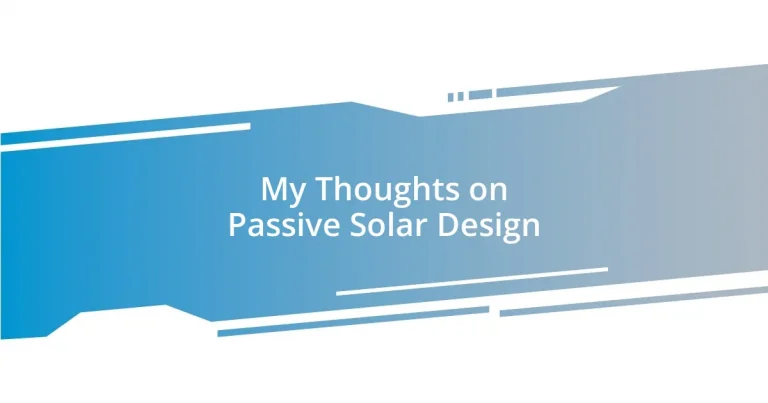Key takeaways:
- Passive solar design utilizes natural energy through architectural choices like window placement and thermal mass for heating and cooling.
- Benefits include significant cost savings, consistent indoor comfort, and a stronger connection to nature.
- Key principles involve building orientation, the use of thermal mass materials, and effective insulation strategies to optimize energy efficiency.
- Common mistakes include neglecting window orientation for solar gain, improper shading considerations, and inadequate insulation which can diminish the effectiveness of passive solar design.
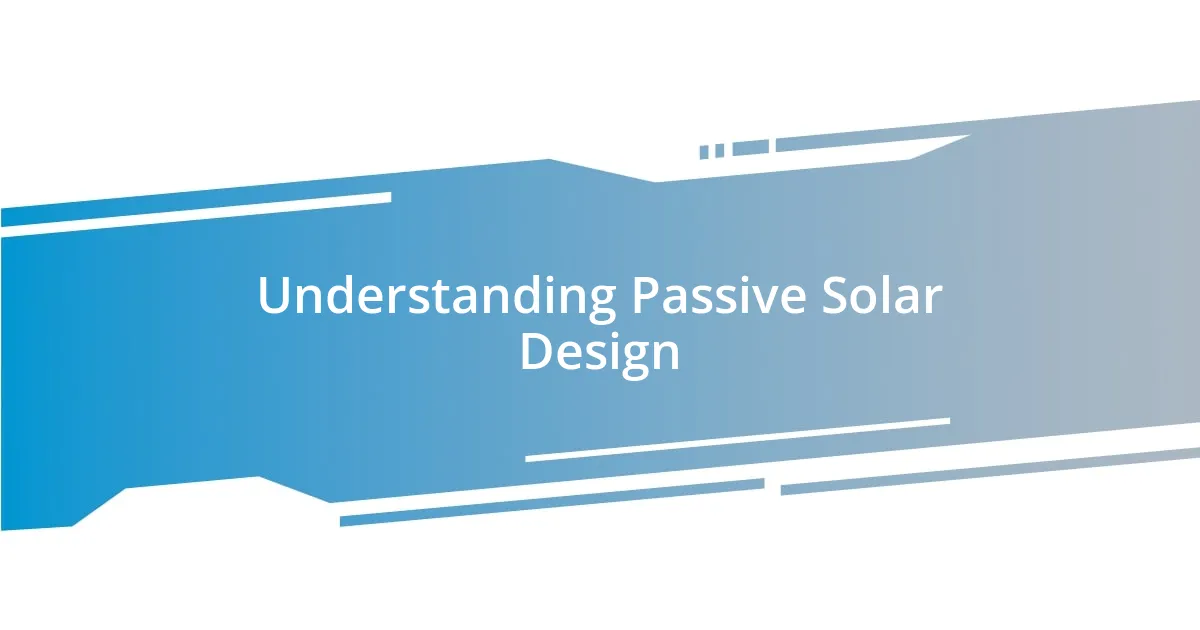
Understanding Passive Solar Design
Passive solar design is an innovative method that utilizes natural energy sources to heat and cool living spaces without mechanical systems. I remember the first time I stepped into a home designed with these principles; the warmth from the sun felt inviting, wrapping around me like a cozy blanket. Isn’t it remarkable how sunlight can be harnessed to create comfort and wellness?
At its core, passive solar design relies on smart architectural choices, such as strategic window placement and thermal mass materials, which absorb and redistribute heat. I often find myself drawing comparisons to cooking—just like placing a pot on a stove to harness the heat from below, homes can be crafted to capture sunlight efficiently. I can’t help but wonder: how many homes could benefit from this knowledge?
Moreover, embracing passive solar design is not just about individual comfort; it’s also a sustainable choice that can lead to reduced energy bills and lower carbon footprints. The thought of contributing to a healthier planet through simple design choices gives me a sense of purpose. Have you ever thought about how your living space could evolve to embrace the sun’s natural rhythms?
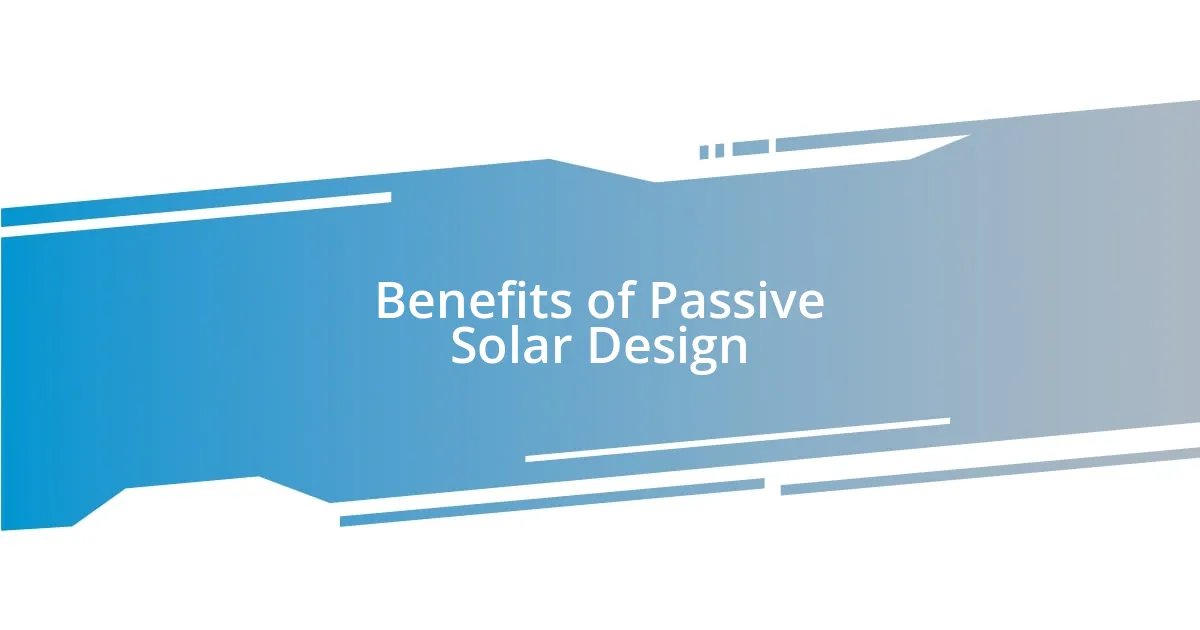
Benefits of Passive Solar Design
The benefits of passive solar design are truly multifaceted. One of the most significant advantages I’ve experienced is the dramatic reduction in heating and cooling costs. For instance, in my own home, after implementing passive solar strategies, I noticed my energy bills dropped by nearly 30%. This financial relief is a fantastic incentive to rethink how spaces are designed.
Another compelling benefit is the enhanced comfort that comes from effective temperature regulation. I often find myself delighting in how evenly sunlight warms my living spaces throughout the day. Unlike traditional heating methods, which can create hot and cold spots, passive solar design offers a smoother, more consistent temperature. It’s like a gentle embrace, making my home environment feel more welcoming.
Lastly, I appreciate how a well-designed passive solar home can contribute to a deeper connection with nature. Large, strategically placed windows not only invite sunlight but also frame beautiful outdoor views that change with the seasons. Watching the foliage transform in autumn from my living room has become one of my greatest joys. This connection to the outdoors fosters peace and tranquility that is hard to replicate with artificial lighting and temperature control.
| Benefit | Description |
|---|---|
| Cost Savings | Significantly reduces energy bills through efficient heating and cooling methods. |
| Comfort | Provides consistent indoor temperatures, eliminating hot and cold spots. |
| Connection to Nature | Enhances natural light and views, fostering a peaceful living environment. |

Key Principles of Passive Solar
One of the key principles of passive solar design is the strategic orientation of a building. I remember walking through a home that faced south, where the sunlight poured in through expansive windows during winter, warming the space beautifully. It’s fascinating to see how the sun’s path can be harnessed to maximize heat gain in colder months while minimizing it during the heat of summer.
Another crucial aspect is the use of thermal mass, which includes materials that absorb and retain heat. For instance, in my previous home, the concrete floors not only felt cool underfoot on hot days but warmed up by the sun and released their heat during the evening. This interplay between materials and sunlight creates a living environment that responds intuitively to nature’s rhythms, enhancing our comfort and minimizing energy usage.
- Orientation: Positioning the building to capture sunlight maximizes heat in winter while shading it in summer.
- Thermal Mass: Utilizing materials like concrete or stone that absorb and slowly release heat effectively regulates indoor temperatures.
- Insulation: Proper insulation prevents heat loss, maintaining a comfortable environment throughout the year.
- Window Design: Strategically placed windows not only enhance natural light but also facilitate airflow and temperature control.

Materials for Passive Solar Design
When choosing materials for passive solar design, I find that glass plays a pivotal role. In my own experience, opting for high-performance, low-emissivity (low-E) windows has made a significant difference in how much heat enters or escapes my home. Each time I sit by those windows during a chilly morning, I’m reminded of how much warmer and cozier my space feels compared to spots with standard glass. Isn’t it amazing how a simple change in window type can elevate your comfort?
Another critical component is thermal mass, which I’ve personally utilized with materials like brick and stone. I recall days when the sun beat down on my patio; the bricks absorbed that heat, keeping the space warm even after the sun set. It’s intriguing to think about how nature’s cycles can be mirrored in our homes. Have you ever noticed how a well-thought-out material choice can create such a harmonious balance with the environment?
Insulation is also incredibly important in passive solar design. I vividly remember insulating my walls with eco-friendly materials, which not only helped maintain a steady indoor temperature but also made the space feel more serene. It’s hard not to smile when I think about how cozy and quiet my home has become, reflecting a commitment to both sustainability and comfort. Why settle for fluctuating temperatures when you can create a sanctuary that works in tune with the seasons?
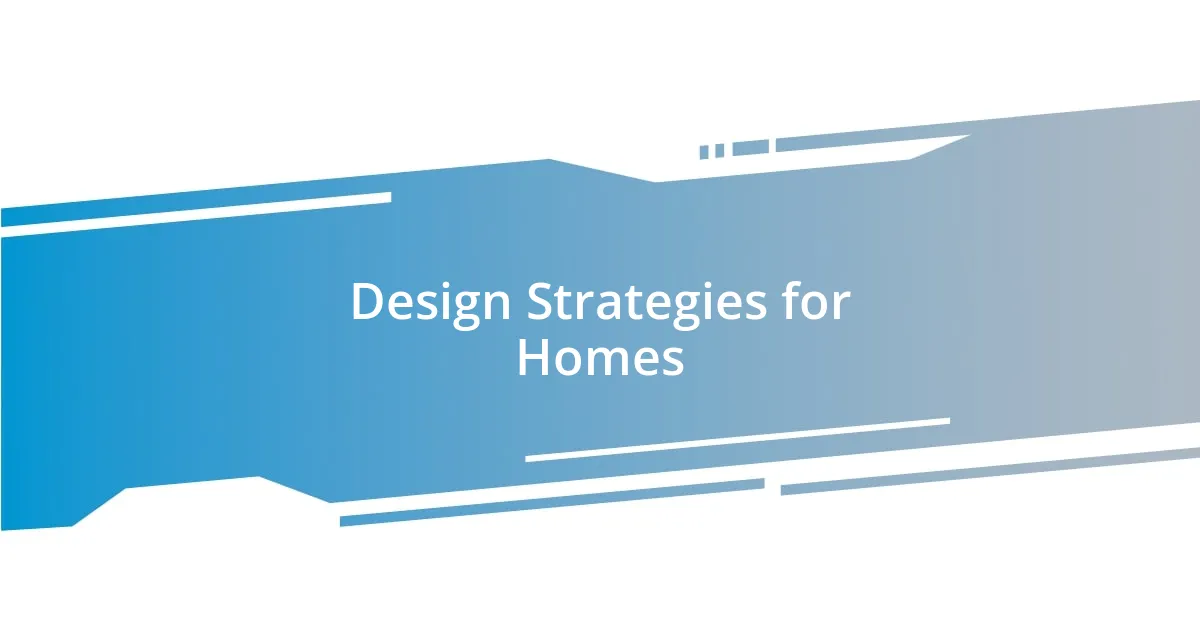
Design Strategies for Homes
When it comes to designing homes with passive solar strategies, I’ve found window placement to be a game-changer. A dear friend of mine installed large south-facing windows, and the difference was staggering. On winter days, it’s like the sun graciously fills the room with warmth, reshaping how they experience their space. Have you ever sat in a sun-drenched room and felt that unique, comforting glow? It’s a reminder of how thoughtful design can enhance our day-to-day lives.
Insulation, in my experience, extends beyond just keeping the cold out. I remember upgrading to spray foam insulation—it’s like wrapping the house in a warm embrace. Suddenly, each room felt uniformly cozy, with no drafts or chilly spots. The right insulation not only improves energy efficiency but also creates a profoundly peaceful environment. Doesn’t that sound inviting?
Moreover, I’ve observed that using thermal mass effectively can transform how a home interacts with its surroundings. During summer gatherings, the cool stone walls retained the night’s chill, making the space remarkably comfortable as the sun rose high. It’s fascinating how materials can work with the natural elements so seamlessly. Have you noticed how a well-designed home can feel alive? Embracing these strategies can lead to a harmonious balance between comfort and sustainability, making your living space truly special.
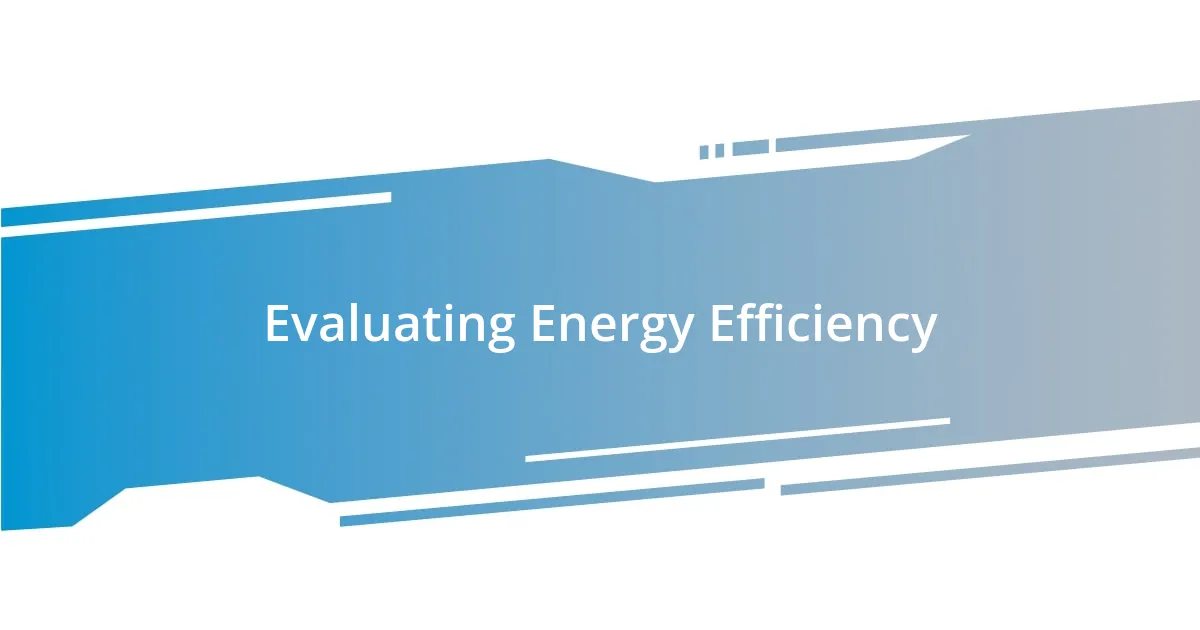
Evaluating Energy Efficiency
Evaluating energy efficiency in passive solar design requires a keen eye for detail and an understanding of how our choices impact overall performance. I remember the first winter after I adjusted shading devices on my windows. The simple act of tilting them slightly changed how much heat entered my home, allowing me to find a balance between warmth and glare. Can you imagine how much comfort can be derived from such a small change?
Another aspect that often gets overlooked is the orientation of the house itself. I’ve personally witnessed the difference it makes to have my home facing the right direction. There’s a certain joy in watching the sun rise and pour in through the windows, knowing that the energy it provides is being harnessed efficiently. Have you felt that surge of warmth fill your space and, in that moment, realized just how powerful the sun can be?
Finally, I dive into energy-efficient appliances, which can be the unsung heroes in a passive solar setup. When I upgraded to Energy Star-rated appliances, the reduction in my utility bills was almost immediate, which was truly gratifying. It’s amazing how integrating sustainability into our daily lives goes hand in hand with improved comfort and savings. Have you ever considered how these everyday choices can contribute to larger environmental goals while enhancing your living experience?

Common Mistakes to Avoid
When diving into passive solar design, one common mistake I see is neglecting the importance of windows’ solar gain potential. I remember a time when a neighbor installed beautiful windows but didn’t consider their orientation. As a result, those stunning features let in too much heat during summer and too little during winter, creating uncomfortable living spaces. Isn’t it ironic how what was meant to enhance their home did the opposite?
Another misstep frequently encountered is overlooking the role of shading. I once installed awnings on my windows but forgot to account for the trees that had grown over the years. Although the awnings were designed to provide shade, they ended up blocking essential winter sun. Have you thought about how seasonal changes influence your home’s energy dynamics? It’s a lesson in understanding our environment more deeply.
Lastly, inadequate insulation can truly derail the benefits of passive solar design. I recall a friend who renovated their home with grand intentions but skipped the insulation upgrade, hoping to save on costs. The drafts were relentless, and it practically negated the warmth from their lovely south-facing windows. Have you experienced how vital that cozy barrier can be in creating a warm haven? Proper insulation shouldn’t be an afterthought; it’s essential for making the most of your design choices.












